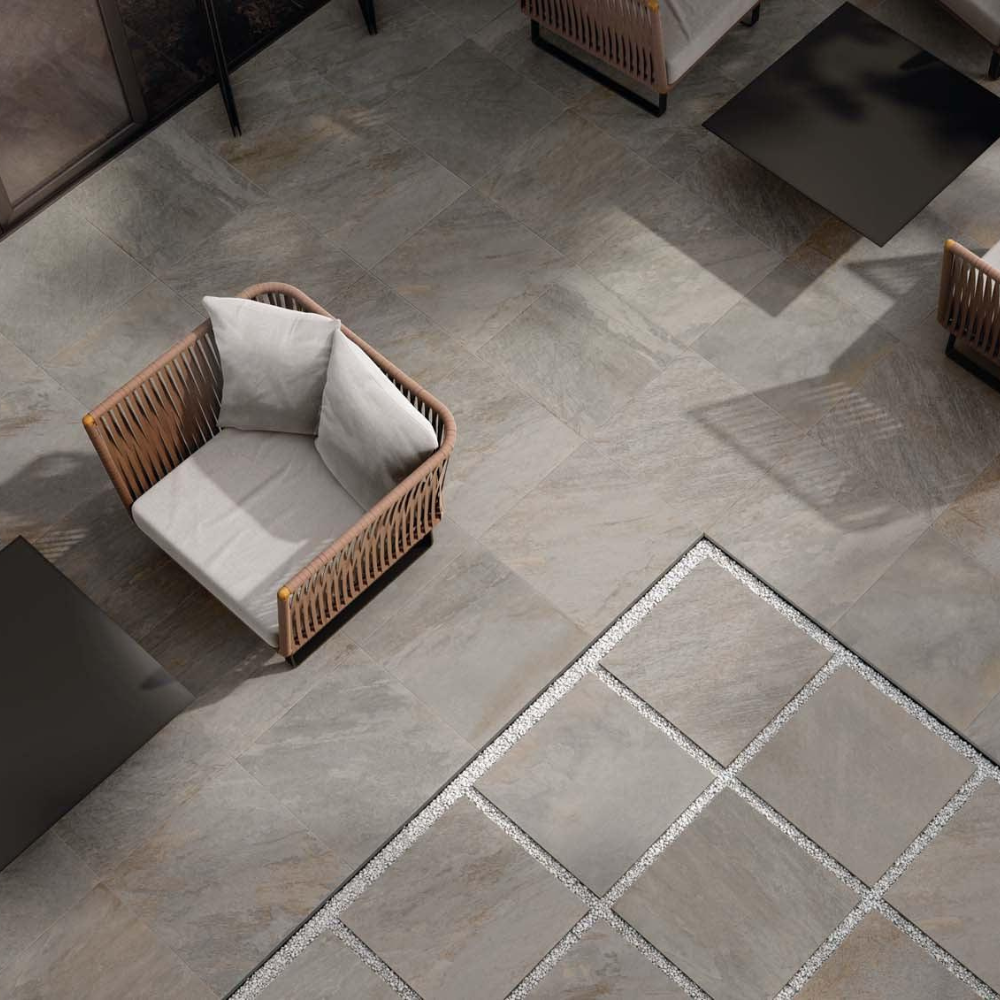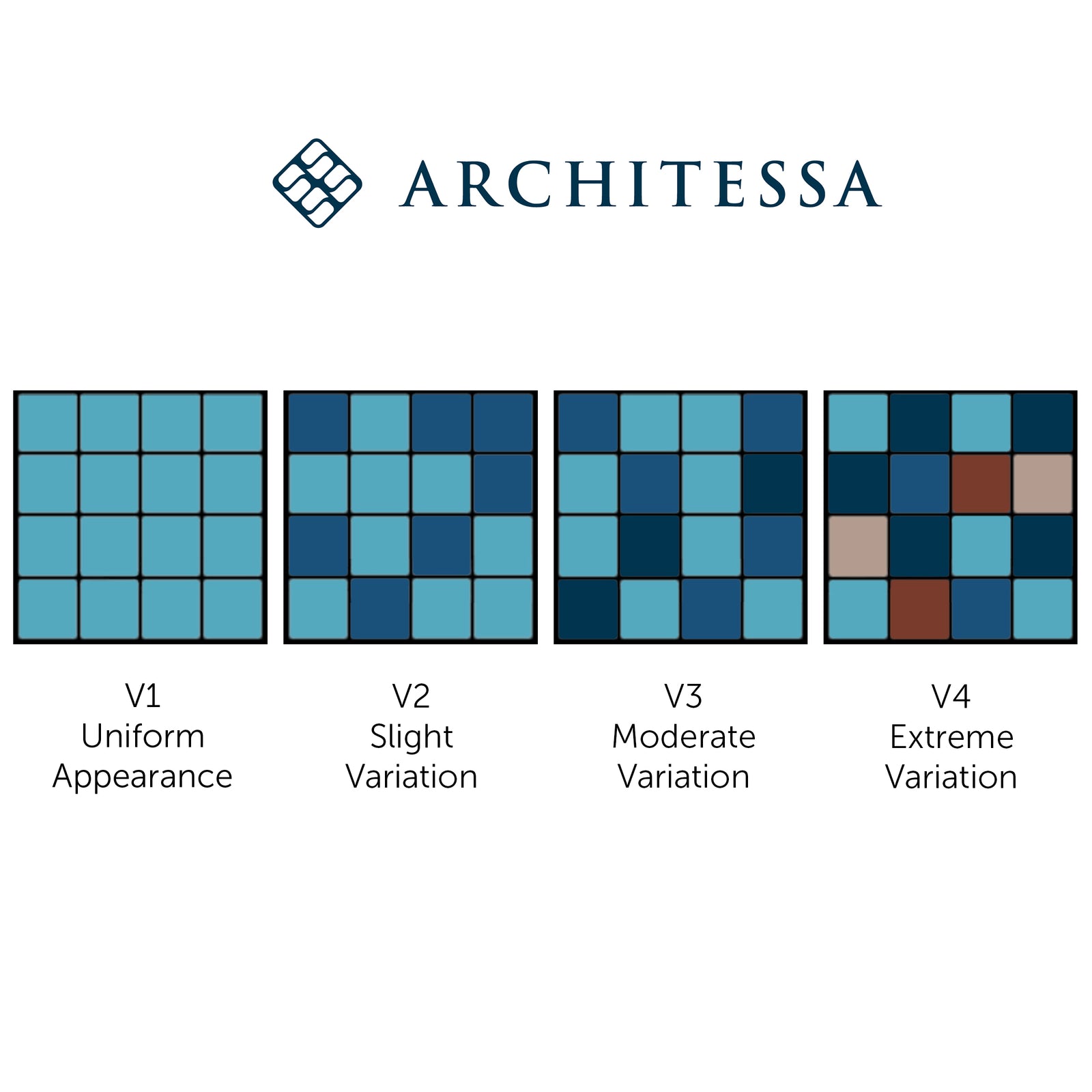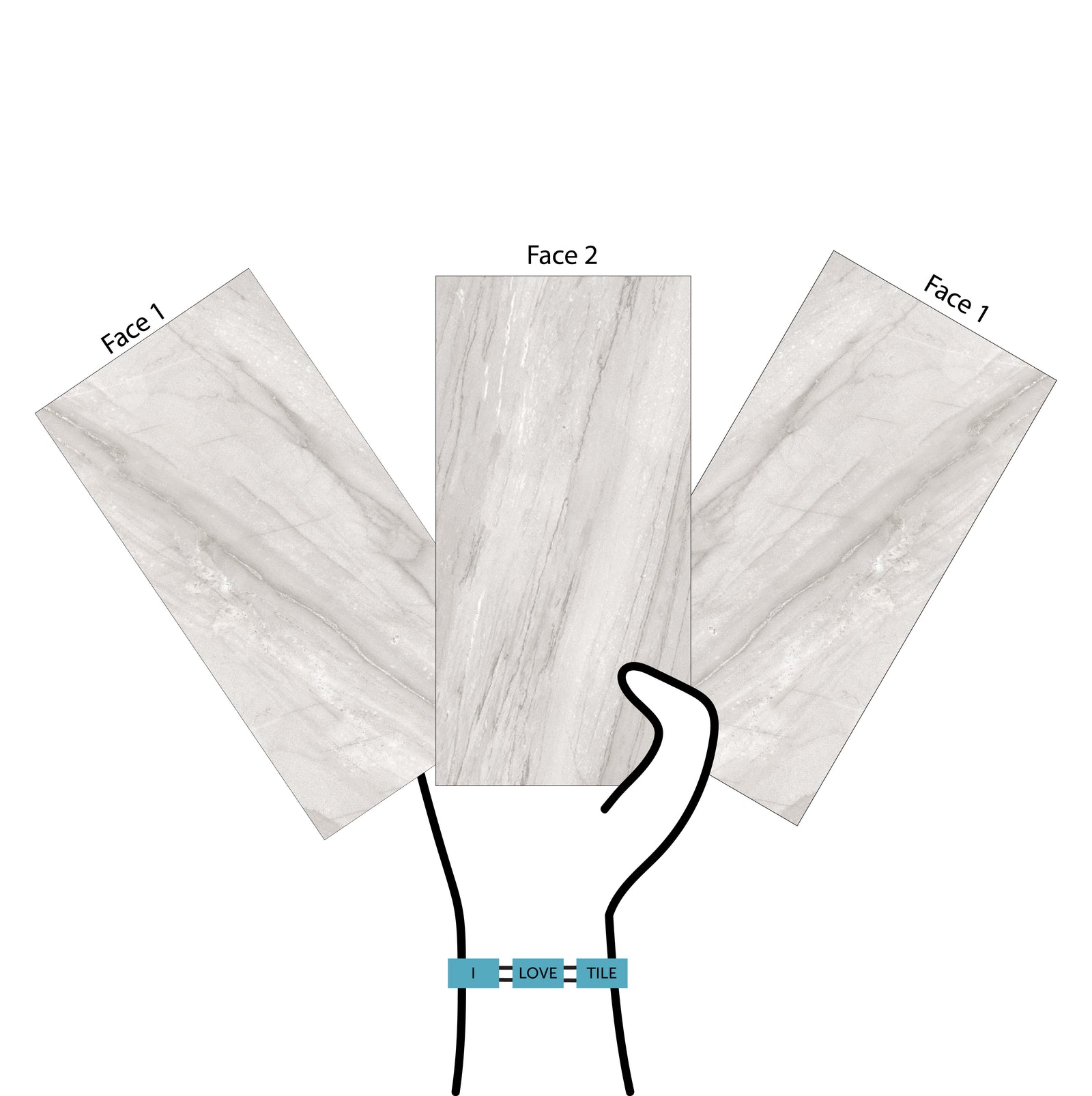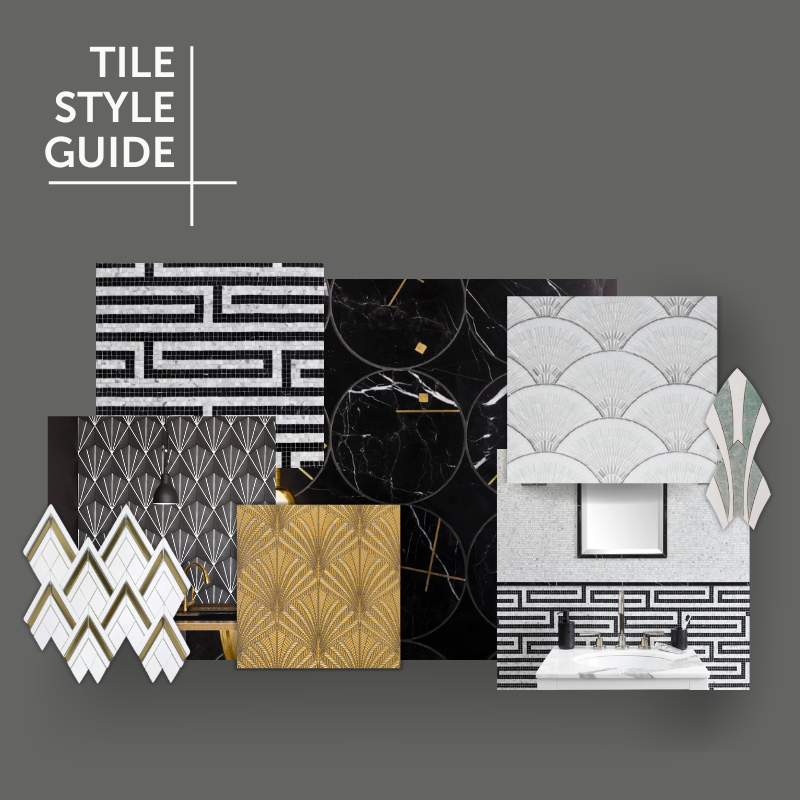Your Cart is Empty
Buying or specifying tile is a journey that takes some training to traverse. Architessans have spent many lifetimes (across our staff) learning about material & the industry, but there are some key things you should know before buying or specifying tile. Ceramic Tile 101 covers tile terminology, product browsing tips, and other helpful things to foster your buying experience.
Ceramic tile is one of the most aesthetically versatile construction materials, offering infinite combinations of colors, textures, sizes, and shapes. Ceramic tile is also one of the healthiest flooring choices available—it is the easiest to clean and is free of harmful toxins, all without compromising on artistry. Ceramic tile is a fantastic whole-project option because it has the lowest environmental impact of popular flooring types without sacrificing style or functionality. Here are just a few of the benefits of ceramic tile:
HEALTH BENEFITS
DESIGN BENEFITS
SUSTAINABILITY BENEFITS & MORE
Tile use is the primary factor for determining which finish to specify. The secondary factor is style. There are dozens of finishes available, however, a few make up the majority of the mass tile market.
Note: Mechanically enhancing the surface of natural porcelain to a polished or special finish opens up tiny micropores on the tile's surface. This is why some manufacturers will recommend sealing.
Unsure what a "battiscopa" is?
We've got you covered.
Next time you hear an unfamiliar word associated with tile, browse our extensive Tile Dictionary with definitions of hundreds of both common and uncommon tile terms.
Tile Dimensions- Tiles sizes are displayed in nominal size (approximate size). When tiles are kiln-fired, each batch can vary by a few mm. When shopping for porcelain slabs, always confirm that your fabricator knows the exact size.
Tile Edges (Rectified vs. Pressed) - A rectified tile is defined by its extra step in the manufacturing process, which mechanically grinds each side to achieve precise and consistent dimensions.
The most sought-after feature of rectified tile is that the uniform size allows tile to be installed with grout joints as small as 1/16”.
Tiles that aren't rectified are known as “pressed” with a factory edge and vary slightly in size from each production run. Although often unnoticeable to the human eye-- due to the slight size variations, 3/8" grout joints are needed to align the tile correctly during installation. Smaller joints result in a floor that may become misaligned at some point during the installation. Rectified tiles are more expensive than pressed tiles due to the extra steps to manufacture.
Tile Patterns- It is important to note that in a multi-sized pattern with rectified tiles you must use tiles with the same calibration. Calibration is a sorting process that manufacturers may use to ensure all tiles within packaged boxes are dimensionally consistent. During the manufacturing process, unfired ceramic tiles are nearly identical in size when they exit the press, but the firing process in the kiln will cause the tiles to shrink–perhaps at slightly different rates from piece to piece. Through calibration, manufacturers sort tiles based on the finished size.
Tiles are typically grouped into two to four different calibers based on the strict sizing requirements of the industry. Calibrated tiles are typically allowed no more than +/-0.5% variation from the average dimension of the corresponding caliber, not to exceed +/- 2mm.
Tile Thickness - When mixing more than one tile on the same plane, have an installation discussion on the thickness to ensure design viability and account for budget requirements. Using pencil trims or liners can help between material transitions. Field tile is typically 8-9mm thick (1cm), whereas outdoor pavers are twice as thick, hence the 2cm nomenclature.
Large Format- The Tile Council of North America defines large format tile as having at least one edge longer than 15", and the TCNA Handbook offers specific recommendations for their installation. For non-technical purposes--such as shopping for tile--large format is defined individually. At Architessa, it's defined as 18x36 or larger.
EPOXY GROUT
The evolution of grout has made more colors available today than ever before and has made epoxy-based grouts (SpectraLOCK) formulated for residential use, where they previously were only used in sanitary commercial applications.
SUBWAY TILE GROUT
Matching the color of your tile creates a more subtle look, whereas a contrasting grout color makes the shape & pattern the grand feature.
GROUT LINE THICKNESS
Minimum grout line thickness always depends on if your tile is manufactured with a rectified or pressed edge. This should be discussed with your salesperson and installer in order to meet the projects design aesthetics.
Rectified= 1/8” typical minimum grout joint
Pressed = 3/8” typical recommended grout joint
Read about 2cm tile pavers, cladding, and other tile for outdoor applications in our blog.
Explore suitable products for landscape architecture projects & bookmark this resource.
Let's put aside the technicalities for now and talk about tile in design. Tile is a critical component of interior and exterior design. It can create aesthetics that no other material can while also being capable of emulating the texture and material of any other type of surface. Learn how tile plays into classic interior design styles in our Style Guides, how to use the versatile checkerboard pattern layout, and why it is important to understand tile shade variation, tile dye lots, and tile faces. Don't forget to sign up for our blogs to stay in the know and be the first to receive our free guides and blogs.
The Ceramic Tile Distributors of America (CTDA) created a shade variation guide to provide buyers and specifiers of ceramic and porcelain tile an overall indication of color, shade, and texture variations that can be expected with a particular tile.
The color shade or shades of all tiles varies some degree from piece to piece, from each production run to run. V1 shade variation has little to zero change from piece to piece, whereas V4 will have a large variety of color and/or texture changes. Note that the TCNA uses a scale of 0-4, shown in the TCNA Handbook, adding V0 - "very" uniform appearance.
At least several pieces or a dry-lay are required from the same production run in order to review and confirm shade variations. Any questions or concerns about your tile selection should be addressed before installation. Please note that shades of color are seen differently on computer monitors, so view a sample if desired.
Ceramic tile is an earth-based material with a natural composition that becomes resistant when fired at very high temperatures. This process, however, can cause slight differences in the shades of color of a tile between one batch and the next.
Tiles are grouped before packaging according to their “dye lots” or shade and their caliber. The “dye lot” (or shade of that batch of material) is then indicated on the label of every box in a fairly long chain of numbers and letters.
When placing your order for tile, it is very important to order enough tiles to not only complete the job but also to have extra for any repairs that may need to occur sometime down the line. Depending on the specified pattern, up to 20% extra may be needed to account for cut and pattern waste.
It is important to know that not all manufacturers batch their tile by shade and this is not correlated to a lower quality product.
The tile industry is constantly innovating, design and format-wise, from slabs, thinner, thicker, through body veins, anti-bacterial, and more. To date, printing capabilities have been the most transformative of them all. Tile design and pattern have come a long way from silk screen to roto-color to digital printing technology.
The number of faces on a tile can vary from as little as one on basic tiles to over thirty on premium ranges. The industry currently does not provide this information publicly but if it's a concern you can always ask a rep. Digital printing entered the market at the turn of the century and was not perfected until around 2010.
Digital Printing has brought the most realistic images possible and introduced hybrid looks to the market along with added texture and dimension. Most tiles produced in large-scale factories utilize this technology, with a few exceptions such as deep vibrant colors. Read more about Digital Printing here.
Every room has a story behind it, told through colors, textures, and patterns. These elements may be insignificant on their own, but when combined by a designer, they tell a cohesive story with a unique design style. Learn about some of the most popular design styles in our Style Guides and how tile fits into each one.
Checkerboard tile's resurging popularity in recent years is a testament to timeless design, as the pattern first became popular in the 1500s. But checkerboard has evolved from standard black and white into a much wider range of shapes & colors. Learn more in our Expert Guide on Checkerboard Floors.
Don't miss out on the newest tile & tile resources. Subscribe to our email newsletter to be the first to receive our blogs & educational resources.
Tile is built to last, and it is important to understand how long different flooring materials will last and how much they will cost to maintain in the long run. Learn more about how long tile, natural stone, and other flooring materials will last (and how much they will cost) in our Tile Life Cycle Cost Analysis.
There are many technical and design characteristics of ceramic tile to help determine the desired or proper specification from residential to commercial. Tile products and installation are held to some lengthy standards and testing through various stakeholders, outlined below.
CTDA (Ceramic Tile Distributors of America): An international association of distributors, manufacturers, and allied professionals of ceramic tile and related that connects, educates, and strengthens tile and stone distributors. CTDA is also known for having created the Shade Variation Index.
TCNA (Tile Council of North America): A trade organization representing North American manufacturers of ceramic tile, tile installation materials, tile equipment, raw materials, and other tile-related products. The TCNA regularly conducts independent research and product testing, works with regulatory, trade, and other government agencies to offer professional training, and publishes installation guidelines, tile standards, economic reports, and promotional literature. The TCNA publishes the yearly TCNA handbook, an international guide for installing tile.
ASTM (American Society for Testing and Materials): Organized in 1898, ASTM International (ASTM) is one of the largest voluntary standards development systems in the world. It is a non-profit organization, which provides a forum for producers, users, ultimate consumers, and those having a general interest (representatives of government and academia) to meet on common ground and write standards for materials, products, systems, and services.
The TCNA was Formed in 1948, the ASTM Committee C21 researches and develops definitions, test methods, and specifications for ceramic whiteware and related products. This committee typically meets twice a year, usually in the fall and spring. With a group of around 181 industry professionals and experts, C21 has jurisdiction over dozens of sections published in the Annual Book of ASTM Standards.
Many standards developed by C21 include important test methods utilized and referenced commonly by the North American ceramic tile industry. TCNA plays a vital role in facilitating the business of the committee.
ANSI (American National Standards Institute): Facilitates voluntary national consensus standards for ceramic tile manufacturing and ceramic tile installation systems. ANSI A137.1:2019 – American National Standards Specifications for Ceramic Tile is the crucial compliance document for the ceramic tile industry. An American National Standard developed by the Tile Council of North America (TCNA), ANSI A137.1:2019 covers specifications for ceramic tile, offering quality criteria and listing and defining different types, sizes, physical properties, and grading procedures.
ISO (International Organization for Standardization): An international standard-setting body composed of representatives from various national standards organizations. The ISO Technical Committee, ISO/TC189, develops standards for ceramic tiles and related installation materials, including grouts, adhesives, and membranes. These standards include test methods, definitions, specifications, and classifications, which serve to unify the global industry and facilitate international trade.
ISO/TC 189 meets in person annually and several times yearly through web-based and in-person Working Group meetings. With a membership of delegates from approximately 50 countries, the committee represents the diverse interests of the ceramic tile industry worldwide. Serving as Secretariat to ISO/TC 189, TCNA and the U.S. delegation are heavily involved in many of the world's most significant standards development issues facing the ceramic tile industry today.
The following section outlines performance standards, some guided by the Tile Council of North America (TCNA). Not all tile is tested to the degree of detail given below, but rest assured that the tile industry has some of the highest performance standards of hard surfaces, as seen by the below-outlined breadth of technical data. The following section will include:
Grade
Grade is the numerical ranking that reflects tile quality. Architessa exclusively carries Grade 1 material.Grade is not generally publicly reported, so it's important to buy from an established brand with a good reputation.
Grade 1: Highest quality. Recommended for walls or floors.
Grade 2: Similar to Grade 1, but with slight imperfections. Recommended for walls or floors.
Grade 3: Lowest quality. Thinner tile designed for walls, not floors. Floor tiles are allowed on walls. Grade 3 tiles are not allowed on floors.
Abrasion Resistance / Durability of Glazed Tiles
Abrasion resistance is the rating given to a tile product based on the hardness of its glaze to determine the proper usage. It is important to remember that Abrasion Resistance is the result of testing glaze wear over time; therefore, only glazed tiles will have this rating. From a technical perspective, ratings are determined by a measurement of Abrasion Resistance measured on a machine, which counts the number of revolutions under a standard abrasive load. Once the tile begins to show the damage, the revolutions are counted, (from 150 to 1500+) which gives the classification value. See the full Abrasion Resistance Chart here.
Deep Abrasion / Durability of Unglazed Tiles
The abrasion resistance of unglazed ceramic tiles is called "deep abrasion". For unglazed tiles, the judgment of resistance to deep abrasion is made by measuring the length of the groove produced in the proper surface by means of a rotating steel disc, under given conditions and with the use of abrasive material. This apparatus essentially consists of a rotating disc, a storage hopper with a dispensing device for the abrasive material, a test specimen support, and a counterweight. The pressure with which the test specimens are held against the steel disc is determined by calibrating the apparatus against transparent fused silica.
Water Absorption & Moisture
Ceramic tiles are classified into four categories based on the weight of water absorbed as a percentage of tile weight. Porcelain is the only product that neatly fits into the impervious category. Other types of ceramics fall into the other groups based on porosity rate, which differs from product to product, even within the same manufacturer.
Vitrified = When the mix for a porcelain tile (such as silica and sand) is fired, it vitrifies due to the high temperatures. Vitrification (from the Latin vitreum, “glass” via the French vitrifier) means to become glass-like or to be transformed into a non-crystalline amorphous solid. Ceramic tiles are more like cement, in that they are porous and slightly less suitable than porcelain for wet environments, however, most ceramics have low enough porosity rates for wet areas. Porcelain tiles are fired at a much higher temperature than ceramic causing the tile to become fully vitrified (.5% or less water absorption). In reality, all ceramics are vitrified to some extent and the vitrified classification can often be confusing.
Tiles used outdoors must absorb <3% to be frost resistant. In order for a tile to be frost proof it must have an absorption rate of < .5%, which classifies it as porcelain. Frost resistance does not mean frost proof and not all frost-proof tiles are recommended for exterior use. Size, finish, and thickness may also be taken into consideration. Always check with the manufacturer on suitable applications, even with technical data in hand.
DCoF / Slip Resistance
The Dynamic Coefficient of Friction (DCoF value) measures how much friction there is on wet, level floors when walked upon. The results of DCoF testing help us determine the likelihood of a tile surface contributing to someone slipping and/or falling.
According to the ANSI A137.1–2012 standard, ceramic tiles selected for level interior spaces when wet must have a minimum wet DCoF AcuTest value of at least 0.42. Tiles with lower values are not necessarily restricted to dry areas only but rather to applications where they are kept dry when walked upon. In the case of residential bathrooms, the common use of bathmats can accomplish this. Similarly, in doorways, the use of entrance mats can accomplish the same.
Not all products with a DCoF AcuTestvalue over 0.42 are suitable for all applications. The type of use, traffic, contaminants, maintenance, expected wear, and manufacturer's guidelines and recommendations are important and must also be considered by the specifier. This is why the Product Use Classification was established.
Product Use Classification (NEW 2022)
The Tile Council of North America, in collaboration with the American National Standards Institute, now requires tile manufacturers (as well as other hard surface flooring manufacturers) to provide “product use classifications” per ANSI 326.3, based on the properties of slip resistance. Before this chart was established, distributors used product data, and job site requirements to recommend application suitability.
Classification / Reference Identification / Criteria
Product Use Classification is a new standard and will take time for factory self-declared ratings to be established. You should reach out to your rep if you desire to check the self-declared rating on your specification or selection.
R Value / Anti-Slip
Germany and other countries use standard DIN EN 16165; the determination of slip resistance of pedestrian surfaces. The anti-slip rating comes in the form of an 'R-value'. The ‘R’ stands for ‘ramp test’; with the subsequent number indicating an anti-slip grade - 13 being strong, 9 being slight. During the production process, the surface of the porcelain can be modified to have a rougher finish. This is achieved by adding a mineral called Corundum into the glazing mix. Corundum is added to the production line after the digital surface application and before entering the kiln for firing. That means that it crystallizes at the exact same temperatures as each of the other materials involved, so it blends perfectly and creates an anti-slip surface without changing the appearance of the tile.
Most tiles in the US don't have this rating readily available, however the TCNA lab can provide testing when required.
Breaking Strength
Breaking strength is measured by force on an unsupported portion of tile until breakage occurs, expressed in lbs. To Comply with ANSI A137.1 “the average breaking strength is equal to or greater than 250 lbs for the floor, porcelain, quarry, and mosaic tiles and 125 lbs for glazed wall tiles.” Since the breaking strength minimum industry requirement for ceramic tile is a laboratory test of what is mostly an unsupported tile, it isn't directly meaningful in terms of determining what kind of dead and live loads it can endure.
What's more meaningful for your concerns pertaining to how a bonded tile will perform is the compressive strength physical characteristic of the tile. Most porcelain tiles have over 20,000 pounds per square inch compressive strength capacity or better.
Chemical Resistance
ASTM C650 is the standard test method for determining the resistance of ceramic tile to chemical substances. The test is intended for tile that will be used for lavatories, food counters, or similar residential, commercial, or medical installations. Tile samples are placed in continuous contact with a variety of chemicals for 24 hours, rinsing the surface and then examining the surface for visible variation, to seek a grade of “conforms” or “unaffected,” which is a Class A rating.
Our case studies explore specific problems, dilemmas, and considerations when designing or installing tile. They will teach you what to do and what NOT to do when installing certain tiles.






